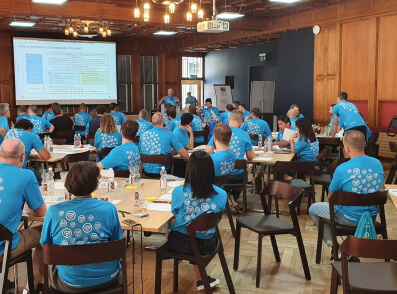Discover the significance of customer engagement and its impact on business success. Learn effective strategies to increase customer engagement and foster lasting relationships with your audience.
Introduction
In a saturated market overflowing with products and services, standing out from the crowd has become increasingly challenging. Today, simply offering quality goods at competitive prices isn’t enough to drive sustainable revenue growth. Instead, companies are turning their focus towards enhancing customer engagement as a key strategy for success.
Understanding Customer Engagement
Customer engagement serves as a vital gauge of trust and closeness between a company and its customers. When customer engagement is high, it signifies a deep sense of trust and intimacy, manifesting in various positive behaviors. These include continued product or service usage, willingness to pay premium prices, and voluntary referrals to others. Such behaviors highlight the company’s strong rapport and positive interactions with its customers.
Distinguishing Customer Loyalty from Engagement
While customer loyalty measures the depth of attachment and trust towards a product or service, customer engagement delves into actual customer behaviors. For instance, if a customer rates their likelihood to recommend a product highly on a scale of 1 to 10, but no tangible action like a purchase or referral follows, loyalty may be high, but engagement remains low.
Distinguishing Customer Satisfaction from Engagement
Customer satisfaction quantifies the level of contentment with a product or service, contrasting with customer engagement, which gauges actual behaviors. While high satisfaction can bolster engagement, it doesn’t guarantee sustained revenue, as satisfied customers may still explore other options.
The Importance of Elevating Customer Engagement
In modern marketing, customer engagement has taken center stage due to evolving market dynamics and shifts in consumer purchasing behaviors. Traditional strategies relying solely on offering quality products at competitive prices are no longer sufficient for ensuring stable revenue growth. Key reasons for this shift include:
Addressing the Challenge of Product Commoditization
The commoditization of products and services underscores the significance of customer engagement. As goods and services lose their unique value and become indistinguishable from competitors, simply offering quality at a low price is no longer a sufficient differentiator. With intensified market competition flooding shelves with similar offerings, brands must seek avenues beyond price and quality to maintain profitability. Cultivating repeat customers requires establishing associations like “the go-to choice” or “reliability” beyond mere product attributes. Thus, fostering trust and intimacy between customers and the brand becomes paramount in avoiding price wars and ensuring sustained profits.
Adapting to Evolving Customer Buying Patterns
The shift in the customer buying journey underscores the growing importance of customer engagement. Previously, consumers relied on company-driven information and imagery to make purchasing decisions. However, the proliferation of smartphones empowers buyers to share their firsthand impressions and sentiments about products and services, significantly shaping purchasing behaviors through word of mouth. A robust base of engaged fans can amplify positive endorsements on social platforms, potentially driving substantial new customer acquisitions in the long run.
Expanded Customer Options
The internet and smartphones have democratized access to information, vastly expanding the array of products and services available. This underscores the heightened importance of customer engagement. Amidst this abundance, customers rely on trust and familiarity with a company to guide their choices, often resulting in decisions driven by brand affinity and confidence.
Unlocking the Advantages of Heightened Customer Engagement
Elevating customer engagement yields myriad benefits for companies. Key advantages include:
Enhanced Repeat Business and Profit Stability
A significant advantage lies in fostering customer loyalty, as they persist in utilizing products and services, bolstering the company’s revenue stability. This ongoing usage cultivates a reinforcing cycle of trust and intimacy with the brand, further deepening customer engagement. Particularly in subscription-based models, a surge in highly engaged customers correlates with decreased churn rates, fortifying long-term profitability.
Amplified Referrals Drive New Customer Acquisition
A notable benefit arises when highly engaged customers naturally share positive feedback about products and services, resulting in an influx of new customers. In today’s digital landscape, word-of-mouth spread through social networks and e-commerce platforms profoundly influences purchasing decisions. Such organic endorsements often wield more promotional power than corporate advertising, helping the acquisition of numerous new customers.
Facilitates Collaborative Value Creation
Elevated customer engagement fosters a collaborative relationship between customers and companies, enabling value co-creation. Highly engaged customers show greater receptivity to company-provided information and are more inclined to participate in surveys and provide feedback. This proactive involvement extends to sharing dissatisfaction, rather than silently defecting to competitors. By integrating customer input, companies can refine their offerings, augment services, and bolster brand esteem, ultimately enhancing overall value propositions.
Boosting Customer Engagement: Actionable Strategies

Wondering how to elevate customer engagement? Here are three tangible steps to achieve just that.
Step 1: Establish Clear Customer Engagement Objectives
Begin by defining long-term customer engagement goals: What type of relationship do you aim to cultivate with your customers? Clarify the desired customer experience and set benchmarks for key metrics like Net Promoter Score (NPS) and Lifetime Value (LTV) to gauge the impact of your engagement strategies. .
Step 2: Assess the Current Landscape and Identify Challenges
Begin by collecting and analyzing customer data to gain insights into the current situation. Gather attributes like age, gender, and location, along with behavioral metrics such as store visits, purchase frequency, and social media interactions. If customer data is fragmented across departments, consider integrating it using a CRM tool.
Once data is compiled, analyze it to create a customer journey map, illustrating how customers discover, engage with, and purchase products/services. This will highlight disparities between desired vs. actual experiences, pinpointing areas for improvement. Prioritize key issues and outline them for immediate attention!
Step 3: Establish KPIs and Implement the PDCA Cycle for Optimal Results
Address the issues identified in Step 2 by brainstorming solutions and implementing the most suitable ones. When choosing measures, consider feasibility, effectiveness, and implementation methods.
It’s crucial to define quantitative, measurable Key Performance Indicators (KPIs) to gauge the effectiveness of solutions.
Utilize the Plan-Do-Check-Act (PDCA) cycle to execute selected measures and assess their impact using KPIs. This iterative process clarifies the most effective solutions for your company, ultimately enhancing customer engagement.
Enhancing Customer Engagement with Effective Tools
The success of strategies to boost customer engagement hinges on adeptly gathering and analyzing customer data, aligning it with suitable actions. For instance, if you operate a health food company, obtaining detailed insights into customers’ health, dietary habits, and wellness concerns allows for nuanced analysis and tailored interventions across customer segments.
To streamline the collection, analysis, and implementation of such granular customer data, we recommend leveraging the ‘dacadoo DHEP’ (Digital Health Engagement Platform).
This platform, utilized by global enterprises, offers an array of engaging features like gamification and social networking, fostering active user participation. By integrating the ‘dacadoo DHEP’ into company apps, organizations can access comprehensive user data encompassing health preferences, medical histories, and lifestyle behaviors. This facilitates the implementation of bespoke strategies tailored to distinct customer segments, such as targeting demographics like ’40-50-year-olds, health-conscious individuals with prior health issues and concerns about future well-being,’ and recommending tailored health products.
To explore the capabilities of this platform firsthand, request a demo. For those contemplating the deployment of user-centric solutions to bolster customer engagement, reach out to dacadoo today for expert guidance.















